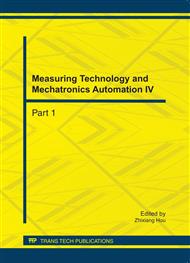p.834
p.842
p.846
p.850
p.855
p.859
p.865
p.870
p.874
Error Analysis of Mechanism with Clearances and Fuzzy Control
Abstract:
The mechanism with clearance is a nonlinear system, then using classical control theory and modern control theory cannot obtain satisfactory control effect. Therefore,In order to control the nonlinear error cause by clearance, the conventional fuzzy control and parameter self-regulation fuzzy control are considered by using the fuzzy control’s humanization and intelligent. The results of test show that: the nonlinear error got smaller and the stability of system got obvious improvement as the introduction of intelligent control system.
Info:
Periodical:
Pages:
855-858
Citation:
Online since:
October 2011
Authors:
Keywords:
Price:
Сopyright:
© 2012 Trans Tech Publications Ltd. All Rights Reserved
Share:
Citation:


